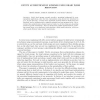Free Online Productivity Tools
i2Speak
i2Symbol
i2OCR
iTex2Img
iWeb2Print
iWeb2Shot
i2Type
iPdf2Split
iPdf2Merge
i2Bopomofo
i2Arabic
i2Style
i2Image
i2PDF
iLatex2Rtf
Sci2ools
DAM
2006
2006
Entity authentication schemes using braid word reduction
Abstract. Artin's braid groups currently provide a promising background for cryptographical applications, since the first cryptosystems using braids were introduced in [2, 3, 18] (see also [22]). A variety of key agreement protocols based on braids have been described, but few authentication or signature schemes have been proposed so far. We introduce three authentication schemes based on braids, two of them being zero-knowledge interactive proofs of knowledge. Then we discuss their possible implementations, involving normal forms or an alternative braid algorithm, called handle reduction, which can achieve good efficiency under specific requirements.
| Added | 11 Dec 2010 |
| Updated | 11 Dec 2010 |
| Type | Journal |
| Year | 2006 |
| Where | DAM |
| Authors | Hervé Sibert, Patrick Dehornoy, Marc Girault |
Comments (0)

